

On October 17, 2003, four male career fire fighters were slightly injured while participating in a live fire training evolution inside a propane-fueled mobile flashover training simulator. Multiple burn evolutions had been conducted over a two and one-half day period without incident prior to the explosion. Minutes after the four-man crew advanced a hoseline into the mobile training trailer, an explosion occurred. The crew members were knocked down by the force of the explosion and became momentarily disoriented, but were able to exit the trailer under their own power. A fifth male fire fighter stationed on the outside of the trailer was also slightly injured when he was hit by an exit door that he was monitoring which was forced open by the blast. NIOSH investigators concluded that, to minimize the risk of similar occurrences, fire departments should:
Additionally, training simulator manufacturers should:
Additionally, the National Fire Protection Association (NFPA) should consider:
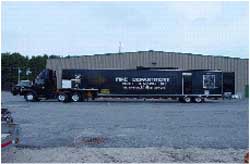 |
Mobile Training Trailer |
On October 17, 2003, four male career fire fighters were slightly injured while participating in a live-fire training evolution inside a mobile flashover simulator (training trailer). A fifth male fire fighter stationed outside the trailer to monitor the exit door was also slightly injured when the force of the explosion caused the door to swing open and hit him. The next week, a consulting firm was hired by the insurance carrier representing the trailer owners to investigate the cause of the explosion. A preliminary report released on October 30, 2003, concluded that the explosion was the result of a carbon monoxide ignition. On November 6, 2003, the International Association of Fire Fighters (IAFF) notified the National Institute for Occupational Safety and Health (NIOSH) of these injuries and requested that NIOSH conduct an investigation into the incident. On December 4-5, 2003, a Safety Engineer with the NIOSH Fire Fighter Fatality Investigation and Prevention Program investigated the incident. Meetings were conducted with the fire department chief officers, the fire training officer, local and state representatives of the International Association of Fire Fighters, and the city safety inspector. The NIOSH investigator interviewed the injured fire fighters, the officers who planned and coordinated the training, the operator of the training trailer during the training exercise, and representatives from the two fire departments who owned the trailer. The NIOSH investigator also discussed the incident with representatives of the company that manufactured the training trailer, as well as an explosion expert at NIOSH and the lead investigator from the engineering consulting firm working for the trailer owners’ insurance carrier. The NIOSH investigator reviewed the fire department’s standard operating guidelines (SOGs), the training trailer operations manual, maintenance records, certified operator log, and a report of the incident contracted by the trailer owners’ insurance carrier. The NIOSH investigator inspected and photographed the trailer. Following the incident, the two fire departments owning the training trailer removed it from service and requested that the trailer manufacturer examine and test the trailer and refurbish it to better-than-new conditions by repairing all damages and upgrading the ventilation system. On April 22 and 23, 2004, the NIOSH investigator returned to witness testing of the trailer by the manufacturer, following refurbishment.
Department
The fire department involved in the training incident is comprised of 237 career
fire fighters, has 7 fire stations, 1 fire boat, 1 air rescue unit and serves
a daytime population of approximately 128,000 (night-time population 65,000)
in an area of about 18 square miles.
Training
The department currently requires all personnel to meet the State fire fighter
requirements and have a minimum of National Fire Protection Association (NFPA)
Firefighter Level 1 certification. The five fire fighters injured during this
incident all met this requirement. On the day of the incident, the fire department
was in the process of having every fire fighter go through live-fire training
in the training trailer over a three-day period. The training evolution was
being managed by a lead safety officer, a lead instructor, and a fire control
officer who had received specialized training from and been certified by the
trailer manufacturer. Note: The trailer operations manual
states that only those persons who have been trained and certified in the safe
operation of the training simulator are authorized to operate the training trailer.
The operations manual specifically states that “only one authorized individual
is to be in the operator control room while a live burn is in progress.”
Equipment and Personnel
Three crews, each consisting of four fire fighters, reported at a time to participate
in the training exercise. At the time of the incident, the following crews were
on-scene:
Engine 1
Ladder 4 (attack crew at the time of the explosion)
Engine 11
Also on scene were the safety officer, lead instructor, and the fire control officer, as well as emergency medical services (EMS) personnel.
Personal Protective Equipment
At the time of the incident, each fire fighter entering the training simulator
trailer was required to wear their full array of personal protective clothing
and equipment, consisting of turnout gear (coats and pants), helmet, gloves,
boots, and a self-contained breathing apparatus (SCBA).
Structure
The structure used for live-fire training purposes in this incident is a fully
self-contained, commercially available flashover simulator and live-fire training
trailer. The trailer measures 52 feet long by 12 feet wide. The trailer is divided
into two compartments, a 40-foot steel burn chamber and a 12-foot equipment
room. The equipment room houses two 420 pound liquid propane cylinders, a gasoline-powered
electrical generator, an air compressor, a smoke-generating machine, an electrical
control panel, and a panel containing gas control valves, flame detector controls,
and safety shut-off valves. The main burn chamber is constructed from a shipboard
cargo container and has a wooden fire-retardant floor and metal walls and ceiling.
The burn chamber contains three gas-fired props constructed of ¼-inch
thick steel plate metal. These props simulate a bed, cabinet, and kitchen range
(see Photo 1). The burn chamber also contains temperature
and gas sensors, and two hinged moveable partitions that can be used to divide
the burn chamber into 3 separate rooms. Each partition has a door in the center
to allow movement throughout the burn chamber. Two ceiling mounted flashover
bars (1-inch perforated pipes) extend from the front of the burn chamber past
the first partition wall. The burn chamber has 3 entrance doors, two windows,
an exhaust ventilation fan, a roof hatch and an operator control room isolated
from the rest of the burn chamber (Figure 1).
The operator control panel located in the control room contains a master on/off switch, touch-screen panel, indicator lights, and an emergency-stop button. The individual props are lit using the touch-screen panel to ignite pilot burners using electronic igniters. Once the pilot burner is lit, the operator must manually operate a hand control valve to supply the desired amount of propane gas to the main burner on each prop. The operator can then control the size and intensity of the flame generated by the main burner by manually operating each control valve (Photo 2 and Photo 4). The flashover bars do not have there own igniters. Propane emitting from the flashover bars is ignited by the flames from the props underneath. Note: The trailer is designed so that only one prop and one flashover bar are intended to be operated at the same time. The operations manual contains a warning indicating that failure to turn off the gas valve once the flashover bar is extinguished… “could result in gas accumulating in the area and cause severe injury to the students, the fire control officer, or other persons in proximity to the area.”
Emergency shut-off buttons are located inside the burn chamber and on both sides of the trailer exterior. The burn chamber contains a temperature sensor which will automatically shut down the system if the ambient temperature inside the burn chamber exceeds 500 degrees Fahrenheit.
The trailer is designed to provide flexibility in presenting a number of training simulations by varying the inner partition walls. The burn chamber can be entered from both sides and the rear. Entry can also be made into the burn chamber down a stairway that leads from the roof to the rear of the burn chamber to simulate attacking a basement fire. Doors in the partition walls can be secured to simulate forced-entry.
The trailer was purchased new from the manufacturer by two neighboring fire departments in February 2002. The trailer was constructed to meet the requirements of the National Fire Protection Association (NFPA) 58, Liquefied Petroleum Gas Code [NFPA 2001].
Fuel
The three burn props and the two flashover bars are fueled by compressed liquid
propane gas (LPG). Two 420 pound steel tanks are mounted vertically in the front
of the equipment room to provide fuel to the props and flashover bars. (Photo
3)
Weather
On the day of the incident, the air temperature was approximately 55 degrees
Fahrenheit with clear skies and calm wind.
On October 17, 2003, four male career fire fighters were slightly injured while participating in a live-fire training evolution inside a mobile flashover simulator training trailer. A fifth fire fighter stationed outside the trailer was also slightly injured. These fire fighters were taking part in a three-day training exercise in which the fire department sought to have every fire fighter in the department go through a series of live-fire training evolutions. The fire department contracted with two neighboring departments to use a mobile flashover simulator training trailer owned by the two neighboring departments. The agreement called for the departments owning the trailer to present the training by providing a safety officer responsible for the overall safety of the training exercise, a lead instructor responsible for the trainees inside the training trailer, and a fire control officer (operator) who is responsible for the set-up and operation of the training trailer
The fire department coordinated the scheduling of individual apparatus companies to attend the training exercises so that every fire fighter in the department would go through the live fire training. Three companies (four-man crews) reported to the training site at a time. The three companies rotated through the training exercise with each company acting as the attack crew, backup crew and standby. Each attack crew experienced three evolutions inside the trailer. The first evolution involved advancing a 1 ¾-inch hoseline through a side door, turning toward the front of the trailer, forcing open the partition doors and then proceeding forward to extinguish the props. The second evolution involved advancing the hoseline from the top of the trailer down the interior stairway, turning left, forcing open the first partition door, and then advancing to the front of the burn chamber to extinguish the props. As the attack crew advanced the hoseline, the fire control officer would randomly operate the bed and cabinet props and the flashover bar. The stove prop was not used during the training exercise. The third evolution involved studying fire progression through a simulated flashover. The two partitions were opened and the attack crew advanced to the center of the burn chamber. The fire control officer would light one of the props and then use the two flashover bars to simulate fire progressing through flashover. Each attack crew was briefed by the attending safety officer on what to expect during the training exercise prior to entering the trailer. This briefing included how the training exercise would be conducted, location of emergency shut off buttons, location of the lead instructor inside the burn chamber, and how to direct water toward the props to extinguish the flames without damaging the burners. Each burn evolution would last approximately 5 minutes. In accordance with the manufacturer’s operations manual, the trailer was ventilated for one minute between each burn evolution by turning on the exhaust fan and opening the side doors and windows. This training exercise was the first time that the department had used the mobile training trailer.
The propane tanks were refilled between the second and third days of the training exercise. The fire control officer reported trouble igniting the props on the morning of the incident (the third morning).
At the time of the incident, the attack crew was beginning the second evolution of its three-evolution sequence. The attack crew (Ladder 4) was the second company to enter the training simulator during this three-company rotation. This was also the second three-company rotation of the day. The first training rotation started at approximately 9:00 AM. The companies involved in the incident (Engine 1, Ladder 4, Engine 11) began their rotation about 10:00 AM. Engine 1 was the first company to serve as the attack crew. The fire control officer encountered problems lighting the different props during Engine 1’s burn evolutions. At one point, the advancing attack crew (Engine 1) had to hold up at the second partition door and wait approximately 30 - 45 seconds for the props and flashover bars to light properly. Ladder 4 was the second company to serve as the attack crew during this rotation. During their pre-evolution briefing, the safety officer advised the Ladder 4 crew that the fire control officer was experiencing problems lighting the props and not to use much water to extinguish the flames.
The Ladder 4 crew advanced into the burn chamber during their first evolution without experiencing any problems. During the second evolution, the crew advanced to the first partition. They could see fire in the front of the burn chamber. The nozzleman and second fire fighter (backup man on hoseline) advanced through the doorway. They had not yet begun to apply water to the fire. The Ladder 4 captain was third on the hoseline and was just passing through the doorway when an explosion occurred somewhere in front of the crew, knocking them backward. Just prior to the explosion, three of the four crew members reported seeing a white fog or cloud in the air inside the trailer. None of the crew members received any damage to their personal protective equipment or clothing. None of the crew members saw a “fireball” or experienced an increase in heat at the time of the explosion. They all reported hearing the sound of an explosion and feeling the pressure wave as it knocked them backward. The force of the explosion blew open the trailer’s outer doors and windows. The Ladder 4 crew members were shaken-up and disoriented, but were able to exit the trailer under their own power. A fifth fire fighter, stationed outside the trailer to monitor the left side exit door, was slightly injured when the force of the explosion caused the door to swing open and strike him on the shoulder. A fire department ambulance and EMS crew were dispatched to the training site and the injured fire fighters were treated on scene. None were transported following the incident.
The operator control room is positioned so that the fire control officer has a view of the trailer interior through two glass windows. The fire control officer is supposed to have complete control over the live-fire evolution. Once the safety officer in charge of the training session indicates that all checks have been made and the evolution is ready to begin, he or she informs the fire control officer who then goes through the start up process and lights the props. When the props are properly lit, the fire control officer signals the lead instructor who then directs the attack crew to enter the burn chamber. At the time of the incident, the fire control officer had just lit the bed and cabinet props. The safety officer stepped into the control room to check with the fire control officer about how the burn evolution was progressing. The fire control officer noticed a bright flash inside the burn chamber and heard a loud bang.
The week following the incident, the trailer was moved to a city public works maintenance garage. The trailer was examined by representatives of the fire department, the two departments owning the trailer, and by the investigators hired by the trailer owners’ insurance carrier. The gas lines were pressurized and checked for leaks. No leaks were detected at this time and the investigators hired by the insurance carrier concluded that the explosion was most likely caused by carbon monoxide building up to the lower explosive limit being ignited by the bed and cabinet prop flames.
The exact cause of the explosion was not determined by this investigation. However, there are two plausible scenarios. The first is the accumulation of carbon monoxide to a point above its lower explosive limit of 12% as concluded by investigators for the trailer owners’ insurance carrier. The second is the accumulation and ignition of excess raw propane within the burn chamber. In most cases, propane introduced into the burn chamber would simply be burned off by the prop flames. However, certain situations, such as extinguishing the flashover bar without shutting the flashover gas valve, as highlighted in the operations manual, can lead to the accumulation of raw propane within the burn chamber. Opening the flashover gas valve before the prop flames have reached sufficient height to ignite the propane introduced through the flashover bar could also allow propane to accumulate within the burn chamber. The difficulty noted in igniting and sustaining the prop flames could have also contributed to an accumulation of propane within the burn chamber. Propane is heavier than air and would therefore accumulate near floor level. Explosion experts at NIOSH do not support the theory that the explosion was the result of an accumulation of carbon monoxide. On the day of the incident, the stove prop in the middle section of the trailer was not functioning. Any propane accumulating as a floor layer in the middle section would not have an ignition source to burn it off until the leading edge of the propane gas reached the prop flames located in the front of the trailer. The raw gas monitoring system inside the burn chamber would normally shut down the system before raw propane accumulated to a hazardous level. The movement of the crew entering the middle section of the trailer could possibly have caused a mixing of accumulating raw propane (near floor level) with room air which was then ignited when the leading edge reached the burning props in the front of the trailer producing the relatively weak explosion. Members of the crew reported seeing a white cloud within the burn chamber prior to the explosion. This cloud was most likely the result of introducing cold ambient air into the chamber containing the warm metal props and residual water vapor from previous training evolutions. Table 1 presents a comparison of the properties of carbon monoxide to propane gas. During the incident, the fire fighters inside the burn chamber did not receive any burn injuries or thermal damage to their turnout gear. They also reportedly did not notice a perceptible increase in heat. Carbon monoxide and propane have different chemical properties and thus it is difficult to compare the characteristics of explosions resulting from similar quantities of the two gaseous compounds. Carbon monoxide produces significantly less thermal energy than does the same volume of propane. Also, during an explosion, combustion takes place within milliseconds, which might explain the lack of thermal injury / damage. One would generally expect to observe a fire-ball or bright flash of light during a propane explosion, while a carbon monoxide explosion would produce less light.
Table 1. Properties of Propane and Carbon Monoxide
[NAO (2002), NFPA (1997), Engineering Tool Box (2004)]
Molecular WT |
Specific Gravity (air = 1) |
Flammability Range |
Ignition Temperature |
Btu/FT3 |
|
| Propane C3H8 |
44 |
1.52 |
2.1 – 9.6% |
842°F |
2516 |
| Carbon Monoxide CO |
28 |
0.97 |
12.5 – 74% |
1128°F |
314 |
Discussion: Safe operation and use of any type of equipment is dependent upon following proper operating procedures established by the manufacturer. Modifying operating procedures may lead to an unanticipated situation. Even slight variations in operating procedures can lead to unexpected events which may result in injury or even death to the participants. It is possible that an excess amount of propane was introduced into the burn chamber, possibly through the flashover bars, before the props were properly burning. Once the props were ignited, the flames would then ignite the propane within the burn chamber. Similarly, deviation from the manufacturer’s recommended procedures for ventilating the simulator between burns could lead to an accumulation of carbon monoxide and other products of combustion.
Discussion: Carbon monoxide explosions are relatively rare, but do occur. By design, live-fire training simulators must be tightly built and therefore provide the opportunity for carbon monoxide and other combustion by-products to accumulate. Carbon monoxide monitors are readily available in a number of sizes and configurations from hand-held to rack-mounted designs. In this incident, the trailer is designed to continuously monitor for the accumulation of raw propane and will automatically shut down the system if raw propane is detected at levels above safe limits inside the burn chamber (approximately 25% of the lower explosive limit of propane gas or 0.5% propane). The use of a carbon monoxide detector, either hand-held or integrated into the simulator’s controls, would provide additional assurance that the burn chamber is properly ventilated and safe for continued operation.
Discussion: Standard operating guidelines (SOGs) should be developed to cover training exercises, including the use of live-fire and flashover simulators. These SOGs should address all aspects of the training exercise, including safe operation of the training simulator, Rapid intervention Team (RIT) operations, SCBA use, water supply and hoseline operations. These SOGs will form the foundation as to how the training will be conducted. NFPA 1403, Standard on Live Fire Training Evolutions, does not specifically mention mobile training simulator trailers but does address gas-fired training buildings [NFPA 2002]. Chapter 5 of NFPA 1403 (chapter 5.2.12.2) requires a preburn plan be prepared and utilized during preburn briefing sessions [NFPA 2002]. The SOGs should be in written form and included in the overall risk-management plan for each fire department [Foley 1998]. If these procedures are changed, appropriate training should be provided to all affected members. In this incident, SOGs covering the use of the flashover simulator trailer had not been developed by any of the fire departments involved. The fire departments owning the trailer relied upon the operations manual supplied by the trailer manufacturer as the basis for operating guidelines.
Discussion: The NFPA 1403 Standard on Live Fire Training Evolutions, chapter 5.4.11, states that emergency medical services shall be available on site to handle injuries [NFPA 2002]. In this incident, EMS-trained staff were present during the burn evolutions, but an ambulance was not on site at the time of the explosion. An ambulance was immediately dispatched to the scene following the explosion. In this incident, the injured fire fighters did not require transport to a medical facility. However, if more serious injuries had occurred, delaying transport could have had an adverse impact upon those injured.
Discussion: Live-fire training simulators should be designed and equipped with a ventilation system to ensure that products of combustion are removed in order to prevent the build-up of potentially explosive gas mixtures. Proper ventilation is also important to ensure that fuel gases are efficiently consumed during the live-fire process. The trailer involved in this incident incorporates an exhaust ventilation system that is designed to purge the burn chamber for at least sixty seconds between burn evolutions. However, this exhaust system is located at the back end of the trailer, away from the props. The position of the two partition walls as well as the exterior doors and windows could influence the effectiveness of purging the burn chamber between evolutions. During this training exercise, the trailer doors and windows were routinely opened between burn evolutions to aid in ventilating the burn chamber. After the incident, the trailer was retrofitted with a second exhaust fan located at the front of the burn chamber above the bed and cabinet props.
Discussion: The trailer involved in this incident is designed with hand-operated gas control valves that must be manually opened and closed to control the flow of propane to the various props within the burn chamber. This design allows for the possibility of opening and closing valves improperly, with the potential to lead to unsafe conditions if the manufacturer’s operating procedures are not properly followed. The use of electronic programmable logic controllers would reduce or eliminate the possibility of improper operation. Integrated carbon monoxide and other sensor systems could automatically shut down the system in a fail-safe mode whenever unsafe levels of explosive gases are encountered within the simulator. Additional strategically located fuel sensors and electronic fuel controls would help prevent ignitions from an accumulation of flammable gases.
Discussion: Currently, NFPA standards do not specifically address mobile live-fire training simulators such as the trailer involved in this incident. NFPA 1403, Standard on Live Fire Training Evolutions, does contain requirements for gas-fueled training simulators but this standard is mainly targeted to permanent structures [NFPA 2002]. Many NFPA standards contain performance and design requirements for equipment such as self-contained breathing apparatus, personal protective clothing, fire apparatus and many others. A new standard with requirements covering the performance of propane or natural gas-fueled mobile live-fire training simulators would enhance the safety of fire fighter training by ensuring proper ventilation, fuel consumption rates, safety controls and other features are standardized.
This incident was investigated by Timothy Merinar, Safety Engineer, NIOSH, Division of Safety Research, Surveillance and Field Investigations Branch.
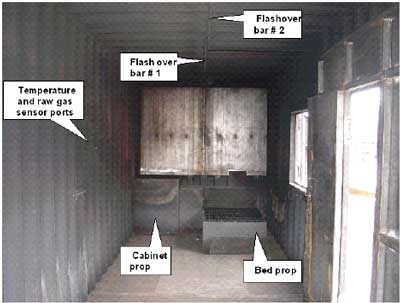 |
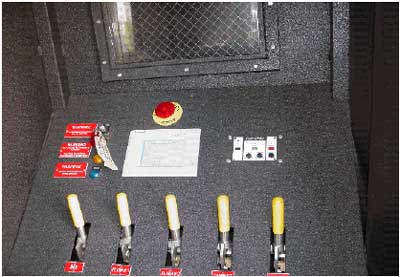 |
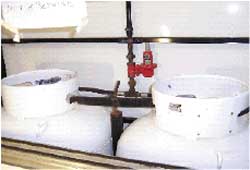 |
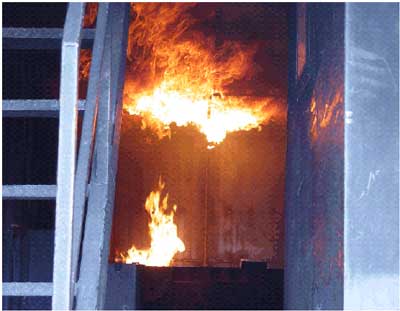 |
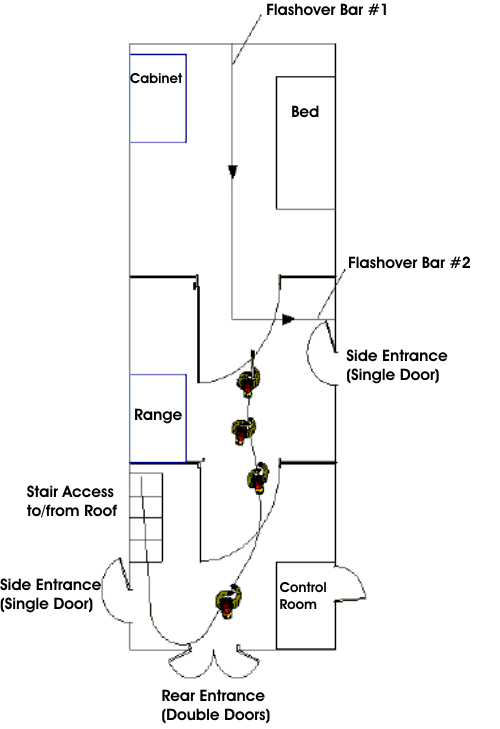 |
Figure 1. Training trailer layout showing location
of Ladder 4 crew at time of explosion.
|
Return to Fire Fighter Homepage
This page was last updated on 12/15/04.